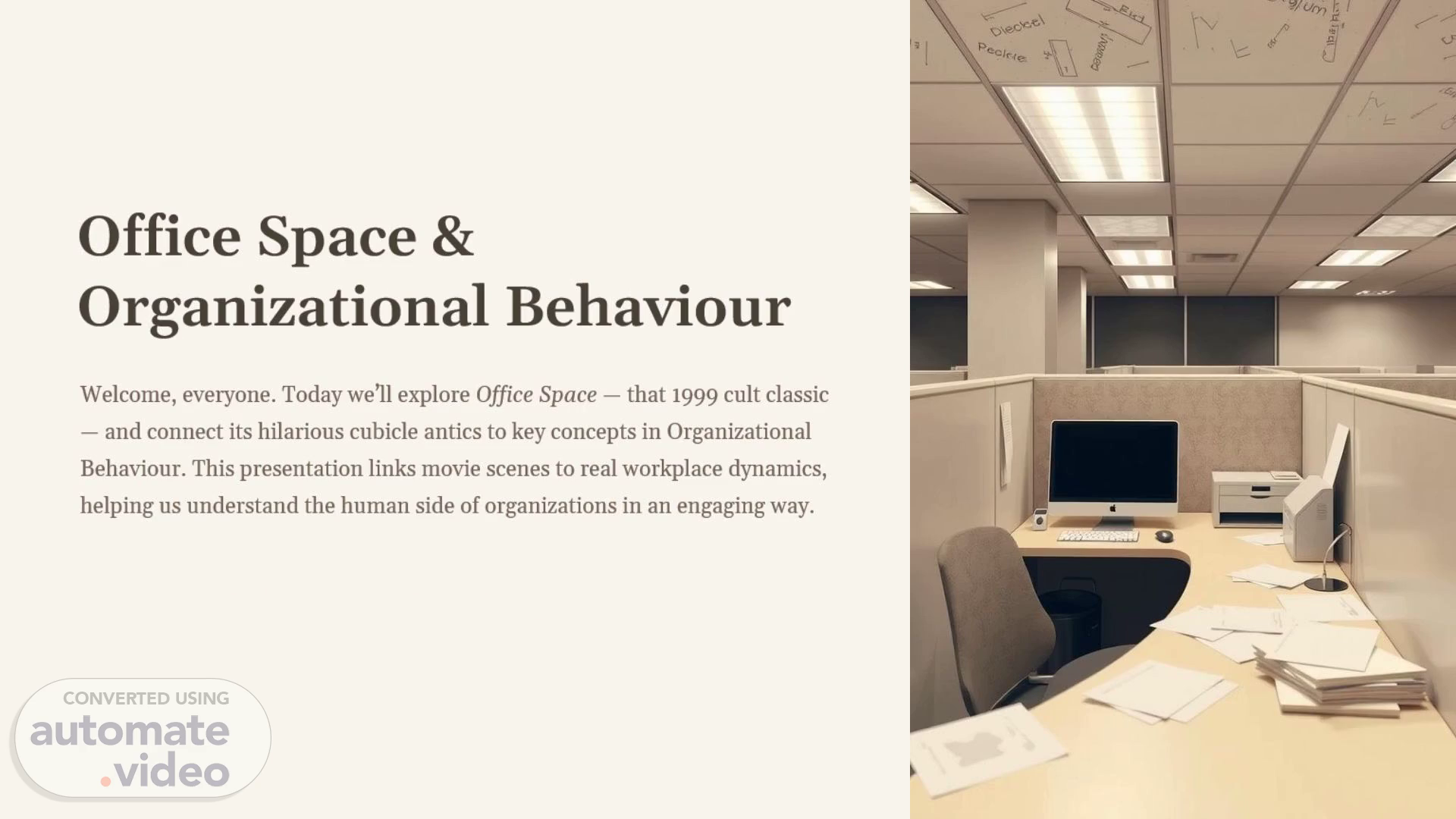Scene 1 (0s)
[Audio] Office Space & Organizational Behaviour Welcome, everyone. Today we’ll explore Office Space — that 1999 cult classic — and connect its hilarious cubicle antics to key concepts in Organizational Behaviour. This presentation links movie scenes to real workplace dynamics, helping us understand the human side of organizations in an engaging way. by Umar, Sahil Ali, and Rafiq.
Scene 2 (28s)
[Audio] Why “Office Space”? Deadpan Humor & Iconic Scenes Explores Workplace Themes The film is famous for its hilarious take on office life, especially the epic printer-smashing moment that resonates with anyone who's faced pointless tech frustrations. Beyond laughter, it reveals universal issues of boredom, red tape, and burnout that plague many organizations worldwide. Living Case Study It offers a nuanced portrayal of how people navigate and sometimes rebel against corporate absurdities..
Scene 3 (1m 1s)
[Audio] Organizational Behaviour 101 Individual Level Group Level Focuses on attitudes, motivation, and how employees think, feel, and act within the workplace environment. Examines team dynamics, communication patterns, and conflict resolution within groups. Organizational Level Studies culture, structure, and leadership, shaping how the entire organization functions. Understanding these areas helps create more productive, meaningful, and humane work experiences..
Scene 4 (1m 37s)
[Audio] Individual Behaviour – Motivation Peter Gibbons’ Journey Herzberg’s Two-Factor Theory Hygiene factors (salary, job security) prevent dissatisfaction Initially a disengaged engineer drowning in TPS reports, hypnosis removes his worries, making him unusually authentic and surprisingly productive. Motivators (autonomy, meaningful work) drive satisfaction Peter embodies intrinsic motivation: by caring less about extrinsic factors, he actually performs better..
Scene 5 (2m 13s)
[Audio] Leadership & Management Styles Bill Lumbergh: Transactional Leader Known for micromanagement and tedious requests like mandatory Saturday work, he symbolizes control over trust. Transactional Leadership Focuses on rules, supervision, and rewards or punishments, typically leading to low employee morale and creativity. Missing Transformational Leadership Inspiration and empowerment are absent. When leaders trust and motivate, innovation and engagement flourish instead of boredom..
Scene 6 (2m 45s)
[Audio] Communication Breakdowns Vague Memos Pointless Meetings Effective Communication Essentials Initech’s staff endure endless, inefficient gatherings that frustrate rather than inform. Confusing and unclear communication increases disengagement and misaligned expectations. Clear channels Timely feedback Active listening Poor communication fosters conflict, lowers productivity, and saps morale..
Scene 7 (3m 17s)
[Audio] Group Dynamics & Resistance to Change Informal Networks Change often starts in these unofficial groups that bypass bureaucratic barriers. Group Cohesion Peter, Samir, and Michael bond over shared frustrations, uniting to challenge corporate norms. Lewin’s Change Model Unfreeze: Recognize dissatisfaction Change: Act to rebel or improve Refreeze: Establish new norms.
Scene 8 (3m 45s)
[Audio] Organizational Culture & Climate Espoused vs. Enacted Values Artifacts & Symbols Everyday items like malfunctioning printers and stolen staplers mirror deeper cultural realities. Initech claims teamwork but rewards compliance, revealing a culture of blind obedience rather than genuine collaboration. Culture is experienced in the daily grind, not just written slogans..
Scene 9 (4m 11s)
[Audio] Job Satisfaction & Well-Being Consequences Milton’s Psychological Contract Breach When employees feel devalued, they disengage, resent the workplace, or retaliate in small or dramatic ways. Repeatedly ignored and relocated, Milton’s expectations for respect and fairness are shattered. Well-being Matters Recognizing and honoring psychological contracts is key to sustaining motivation and reducing burnout..
Scene 10 (4m 41s)
[Audio] Thank you for listening. Thank you for listening.
